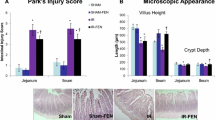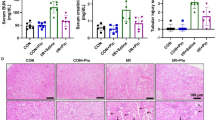Summary
The aim of this study was to investigate the possible beneficial effects of Fenofibrate on renal ischemia-reperfusion injury (IRI) in mice and its potential mechanism. IRI was induced by bilateral renal ischemia for 60 min followed by reperfusion for 24 h. Eighteen male C57BL/6 mice were randomly divided into three groups: sham-operated group (sham), IRI+saline group (IRI group), IRI+Fenofibrate (FEN) group. Normal saline or Fenofibrate (3 mg/kg) was intravenously injected 60 min before renal ischemia in IRI group and FEN group, respectively. Blood samples and renal tissues were collected at the end of reperfusion. The renal function, histopathologic changes, and the expression levels of pro-inflammatory cytokines [interleukin-8 (IL-8), tumor necrosis factor alpha (TNF-α) and IL-6] in serum and renal tissue homogenate were assessed. Moreover, the effects of Fenofibrate on activating phosphoinositide 3 kinase/protein kinase B (PI3K/Akt) signaling and peroxisome proliferator-activated receptor-α (PPAR-α) were also measured in renal IRI. The results showed that plasma levels of blood urea nitrogen and creatinine, histopathologic scores and the expression levels of TNF-α, IL-8 and IL-6 were significantly lower in FEN group than in IRI group. Moreover, Fenofibrate pretreatment could further induce PI3K/Akt signal pathway and PPAR-α activation following renal IRI. These findings indicated PPAR-α activation by Fenofibrate exerts protective effects on renal IRI in mice by suppressing inflammation via PI3K/Akt activation. Thus, Fenofibrate could be a novel therapeutic alternative in renal IRI.
Similar content being viewed by others
References
Mangano CM, Diamondstone LS, Ramsay JG, et al. Renal dysfunction after myocardial revascularization: risk factors, adverse outcomes, and hospital resource utilization. The Multicenter Study of Perioperative Ischemia Research Group. Ann Intern Med, 1998, 128(3):194–203
Aydin Z, van Zonneveld AJ, de Fijter JW, et al. New horizons in prevention and treatment of ischaemic injury to kidney transplants. Nephrol Dial Transplant, 2007, 22(2):342–346
Chertow GM, Burdick E, Honour M, et al. Acute kidney injury, mortality, length of stay, and costs in hospitalized patients. J Am Soc Nephrol, 2005, 16(11):3365–3370
Kazmers A, Jacobs L, Perkins A. The impact of complications after vascular surgery in Veterans Affairs Medical Centers. J Surg Res, 1997, 67(1):62–66
Levy EM, Viscoli CM, Horwitz RI. The effect of acute renal failure on mortality. A cohort analysis. JAMA, 1996, 275(19):1489–1494
Zhang J, Li JH, Wang L, et al. Glucocorticoid receptor agonist dexamethasone attenuates renal ischemia/reperfusion injury by up-regulating eNOS/iNOS. J Huazhong Univ Sci Technolog Med Sci, 2014, 34(4):516–520
Schiffl H, Lang SM, Fischer R. Daily hemodialysis and the outcome of acute renal failure. N Engl J Med, 2002, 346(5): 305–310
Amura CR, Renner B, Lyubchenko T, et al. Complement activation and toll-like receptor-2 signaling contribute to cytokine production after renal ischemia/reperfusion. Mol Immunol, 2012, 52(3–4):249–257
Fan LH, He L, Cao ZQ, et al. Effect of ischemia preconditioning on renal ischemia/reperfusion injury in rats. Int Braz J Urol, 2012, 38(6):842–854
Kusch A, Hoff U, Bubalo G, et al. Novel signalling mechanisms and targets in renal ischaemia and reperfusion injury. Acta Physiol (Oxf), 2013, 208(1):25–40
Kim HJ, Joe Y, Kong JS, et al. Carbon monoxide protects against hepatic ischemia/reperfusion injury via ROS-dependent Akt signaling and inhibition of glycogen synthase kinase 3beta. Oxid Med Cell Longev, 2013, 2013:306421
Hofmann BT, Jucker M. Activation of PI3K/Akt signaling by n-terminal SH2 domain mutants of the p85alpha regulatory subunit of PI3K is enhanced by deletion of its c-terminal SH2 domain. Cell Signal, 2012, 24(10):1950–1954
Chen L, Wei X, Hou Y, et al. Tetramethylpyrazine analogue CXC195 protects against cerebral ischemia/reperfusion-induced apoptosis through PI3K/Akt/GSK3beta pathway in rats. Neurochem Int, 2014, 66:27–32
Rasin MS. Peroxisome proliferator-activated receptors-gamma and hypertension: lessons of the history of researches. Ter Arkh, 2013, 85(9):118–123
Guebre-Egziabher F, Alix PM, Koppe L, et al. Ectopic lipid accumulation: A potential cause for metabolic disturbances and a contributor to the alteration of kidney function. Biochimie, 2013, 95(11):1971–1979
Bulhak AA, Jung C, Ostenson CG, et al. PPAR-alpha activation protects the type 2 diabetic myocardium against ischemia-reperfusion injury: involvement of the PI3-Kinase/Akt and NO pathway. Am J Physiol Heart Circ Physiol, 2009, 296(3):H719–727
Patel NS, di Paola R, Mazzon E, et al. Peroxisome proliferator-activated receptor-alpha contributes to the resolution of inflammation after renal ischemia/reperfusion injury. J Pharmacol Exp Ther, 2009, 328(2):635–643.
Dong C, Hu Y, Wang H, et al. Inhibitory effects of fenofibrate on plasminogen activator inhibitor-1 expression in human endothelial cells. Huazhong Univ Sci Technolog Med Sci, 2006, 26(2):192–193
Retraction note: Effect of preischemic treatment with fenofibrate, a peroxisome proliferator-activated receptor-alpha ligand, on hepatic ischemia-reperfusion injury in rats. J Mol Histol, 2013, 44(4):495
Yang C, Zhao T, Lin M, et al. Helix B surface peptide administered after insult of ischemia reperfusion improved renal function, structure and apoptosis through beta common receptor/erythropoietin receptor and PI3K/Akt pathway in a murine model. Exp Biol Med (Maywood), 2013, 238(1):111–119
Xie L, Zheng X, Qin J, et al. Role of PI3-kinase/Akt signalling pathway in renal function and cell proliferation after renal ischaemia/reperfusion injury in mice. Nephrology (Carlton), 2006, 11(3):207–212
Liu WH, Liu HB, Gao DK, et al. ABCG2 protects kidney side population cells from hypoxia/reoxygenation injury through activation of the MEK/ERK pathway. Cell Transplant, 2013, 22(10):1859–1868
Author information
Authors and Affiliations
Corresponding author
Additional information
This project was supported by the National Natural Science Foundation of China (No. 81070557).
Rights and permissions
About this article
Cite this article
Yang, Fj., He, Yh. & Zhou, Jh. Fenofibrate pre-treatment suppressed inflammation by activating phosphoinositide 3 kinase/protein kinase B (PI3K/Akt) signaling in renal ischemia-reperfusion injury. J. Huazhong Univ. Sci. Technol. [Med. Sci.] 35, 58–63 (2015). https://doi.org/10.1007/s11596-015-1389-2
Received:
Revised:
Published:
Issue Date:
DOI: https://doi.org/10.1007/s11596-015-1389-2




